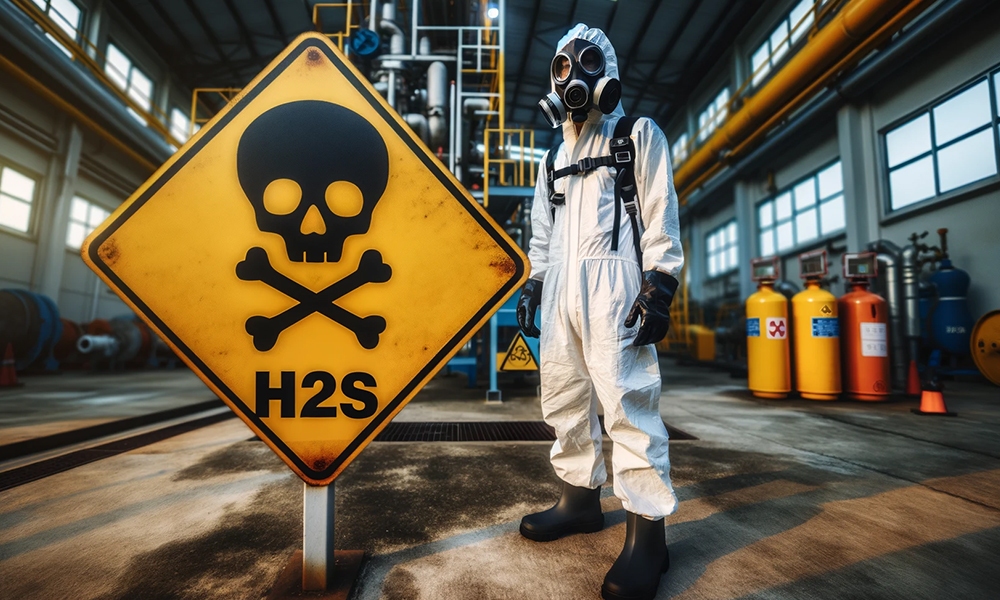
Introduction:
In the realm of industrial safety and environmental health, few substances pose as complex a danger as hydrogen sulfide (H2S). This colorless, flammable gas, notorious for its rotten egg smell, is not just an unpleasant nuisance but a significant health and safety hazard. In this blog post, we’ll delve into the world of H2S – exploring its sources, the risks it poses to health, and the crucial safety measures necessary to handle it.
What is Hydrogen Sulfide?
Hydrogen sulfide is a small, simple molecule consisting of two hydrogen atoms bonded to a single sulfur atom. Despite its simplicity, H2S is highly toxic and corrosive. Commonly found in natural and industrial settings, it’s a by-product of decaying organic matter. From the depths of volcanoes to the intricacies of human industry, H2S makes its presence known.
Sources of H2S:
- Natural Occurrences: H2S naturally emanates from volcanic gases, hot springs, and undersea vents. It is also released during the bacterial decomposition of organic materials in the absence of oxygen.
- Industrial Activities: Key industrial sources include petroleum refining, natural gas processing, and paper manufacturing. It’s also prevalent in sewage treatment plants and farm environments (manure pits).
- Biological Processes: In smaller amounts, H2S is produced by bacteria in the human gut and plays a role in certain physiological functions.
Health Risks of H2S Exposure:
- Low Exposure: Even at low levels (below 10 ppm), H2S can irritate the eyes, throat, and respiratory system, leading to coughing and shortness of breath.
- Moderate Exposure: Increased exposure can severely impair lung function and cause a build-up of fluid in the lungs (pulmonary edema).
- High Exposure: Concentrations over 100 ppm are dangerously toxic, potentially leading to rapid unconsciousness and death.
- Chronic Exposure: Long-term exposure can result in chronic health issues like fatigue, loss of appetite, and neurological problems.
Percentage vs. PPM in Hydrogen Sulfide Measurement:
Understanding the concentration of H2S in the air is crucial for safety. Concentrations are often measured in parts per million (ppm). To put it in perspective, 1% of H2S in the air is a whopping 10,000 ppm, far beyond the threshold for immediate health hazards. This conversion is critical in industries where precision in measuring gas concentrations can mean the difference between safety and disaster.
Safety Measures and Detection:
- Detection Equipment: Due to its ability to deaden the sense of smell, relying on odor for H2S detection is unreliable. Portable or fixed gas detectors are essential for accurate monitoring.
- Ventilation: Proper ventilation in industrial and confined spaces is key to dispersing H2S build-ups.
- Personal Protective Equipment (PPE): In environments with potential H2S exposure, appropriate PPE like gas masks and respirators is crucial.
- Regular Training and Drills: Regular safety training and emergency response drills are vital in high-risk industries.
- Regular Maintenance: Maintenance programs such as leak inspections and equipment calibration cannot be understated.
Conclusion:
Hydrogen sulfide, while naturally occurring and industrially prevalent, presents significant risks. Understanding its sources, health impacts, and the importance of accurate concentration measurement (percentage vs. ppm) is essential for anyone working in environments where H2S may be present. Through vigilant safety practices, regular training, and appropriate detection and protection equipment, the risks associated with H2S can be effectively managed. Let’s respect this simple yet hazardous gas and prioritize safety in all environments where it may lurk.
Author’s Note:
Always remember, safety first! Regular checks and adherence to safety guidelines are not just regulatory obligations but lifelines in the face of hazardous substances like Hydrogen Sulfide. Stay informed and stay safe!

